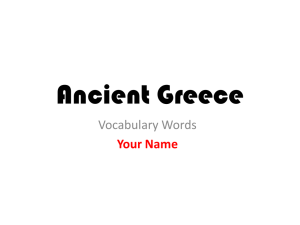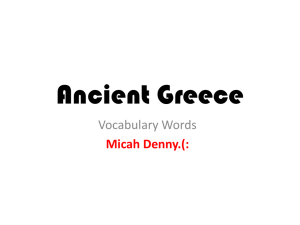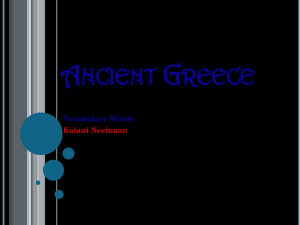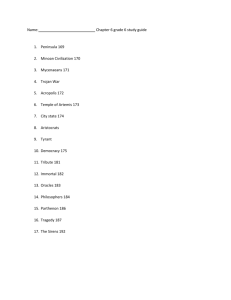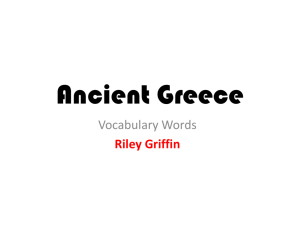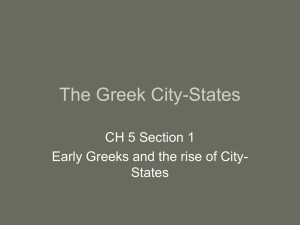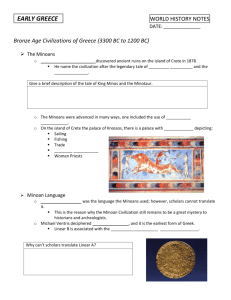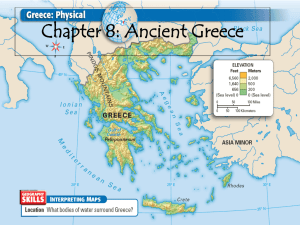Chapter 4 -- Group 4.2
advertisement
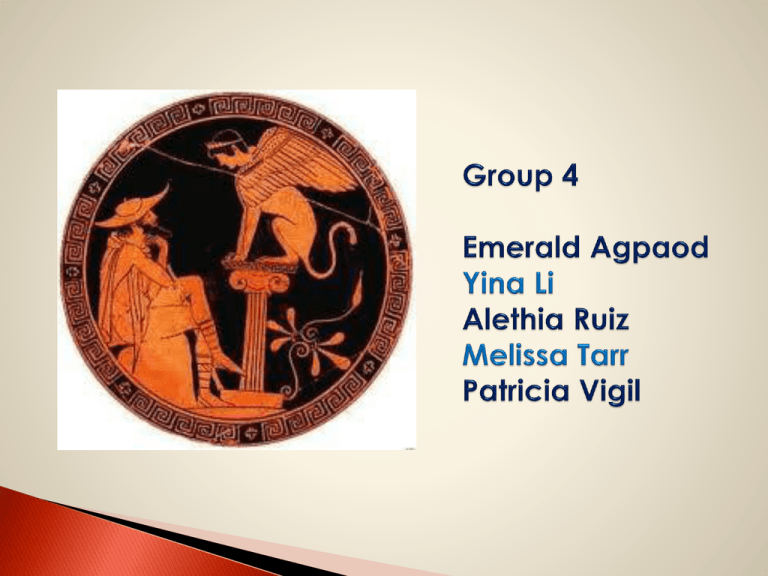
Ancient Greece ◦ The Greeks developed democratic government Early India ◦ The people of India invented the concept of zero Early China ◦ The ancient Chinese created paper Day 1 Section1: The Early Greeks Section 2: Sparta and Athens Day 2 Section 3: Persia Attacks the Greeks Section 4: The Age of Pericles Day 1 6.4 Students analyze the geographic, political, economic, religious, and social structures of the early civilizations of Ancient Greece. 1. Discuss the connections between geography and the development of city-states in the region of the Aegean Sea, including patterns of trade and commerce among Greek city-states and within the wider Mediterranean region. 3. State the key differences between Athenian, or direct, democracy and representative democracy. 6. Compare and contrast life in Athens and Sparta, with emphasis on their roles in the Persian and Peloponnesian Wars. Day 2 2. Trace the transition from tyranny and oligarchy to early democratic forms of government and back to dictatorship in ancient Greece, including the significance of the invention of the idea of citizenship (e.g. from Pericles’ Funeral Oration). 5. Outline the founding, expansion, and political organization of the Persian Empire. 6. Compare and contrast life in Athens and Sparta, with emphasis on their roles in the Persian and Peloponnesian Wars. Crete (KREET) Minoan (muh-NOH-uhn) Knossos (NAH-suhs) Mycenae (my-SEE-nee) Peloponnesus (PEHluh-puh-NEE-suhs) Hoplites (HAHP-lyts) Peninsula Colony Polis Acropolis Agora Mainland Greece Peninsula – a body of land with water on three sides Most made a living from the sea ◦ Fishers ◦ Sailors ◦ Traders Others settle in farming communities ◦ Mountains and rocky soils not ideal for growing crops ◦ Mild climate Grow wheat, barley, olives, and grapes Raised sheep and goats From the island of Crete (KREET) ◦ Southeast from the mainland In 1900 C.E. ◦ Arthur Evans, an English archaeologist ◦ Uncover the ruin of Palace of Knossos, center of Minoan civilization Not Greek ◦ The region later became Greece Twisting passageways ◦ ◦ ◦ ◦ Private quarters Storerooms: oil, wine, and grain Workshops: jewelry, vases, and small ivory statues Bathrooms! Trades ◦ Build ships ◦ Sail Egypt Syria By 2000 B.C.E., ships controlled the eastern Mediterranean Sea About 1450 B.C.E. Minoan civilization suddenly collapsed ◦ Undersea earthquakes ◦ The cities were destroyed invaders Greeks from mainland, called the Mycenaeans (MY-suh-NEE-uhns) In the late 1800’s C.E. ◦ German named Henrich Schliemann discovered a walled palace in Mycenae (my-SEE-nee) ◦ He named the people of this civilization the Mycenaeans From central Asia Invaded Greek mainland around 1900 B.C.E. Palace on a hill ◦ King or ruler ◦ Surrounded by stone walls Large farms ◦ Belongs to the nobles Slaves and farmers live on the estates of the nobles Busy Kingdom ◦ Artisan Tanned leather Sewed clothes Made jars for wine and olive oil ◦ Workers Bronze swords Ox-hide shields Officials kept track of the wealth of every person Collected wheat, livestock, and honey as taxes and stored them in the palace Minoan traders visit from Crete Mycenaeans learned/adapted a lot of the Minoan culture ◦ ◦ ◦ ◦ Work with bronze Built ships Use sun and stars as navigation at sea Worshiping Earth Mother, Chief Goddess Around 1400 B.C.E. the Mycenaeans replaced the Minoans By 1200 B.C.E. ◦ Earthquakes and fighting among kingdoms By 1100 B.C.E. ◦ Mycenaeans civilization collapsed Between 1100 B.C.E. and 750 B.C.E. ◦ ◦ ◦ ◦ Slowed oversea trade Proverty Not enough food Stopped teaching Population shift ◦ Thousands of Greek left the mainland ◦ Settled on islands in the Aegean Sea ◦ Western shores of Asia Minor (present day Turkey) Expanded Greek Culture Lived in Greece’s northern mountains Move to south ◦ Settled in the Peloponnesus (PEH-luh-puh-NEE-suhs) ◦ Iron weapons Began to farm again ◦ Surplus food Increased trade Trade = new way of writing Got the idea from Phoenicians, trading partner Greek Alphabet: 24 letters Writing down tales Population rose quickly By 700 B.C.E. ◦ Not enough food Start colonies – a settlement in a new territory that keeps close ties to its homeland. Between 750 and 550 B.C.E. ◦ ◦ ◦ ◦ ◦ Italy France Spain North Africa Western Asia Grains Metals Fish Timber Enslaved people Pottery Wine Olive oil During 600s B.C.E. ◦ Minting coins Exchanging goods for money Trade Industry ◦ Specializing products i.e. Clay = Pottery Polis (PAH-luhs) is from the word “politics” City-state Made up of a town or city and surrounding countryside • varied in size A tiny independent country Acropolis (uh-KRAH-puh-luhs) ◦ ◦ ◦ ◦ ◦ Main gathering place Fortified area Top of the hill Safe refuge Religious center Agora (A-guh-ruh) ◦ An open area below the acropolis ◦ Two functions Market Place to meet and debate issues First to develop the idea of citizenship City-state run by its citizens ◦ Citizens means… Member of a political community Only free native-born men who owned land Women and children might qualified for citizenship Slave and foreign-born residents were excluded Choose their officials and pass laws Right to vote Hold office Own property Defend themselves in court In return ◦ Their duty to serve in government ◦ Fight for their polis as citizen soldiers By 700 B.C.E. ◦ Armies of ordinary citizens called hoplites (HAHP-lyts) Hoplites ◦ Fought on foot ◦ Heavily armed round shield Short sword 9-foot spear ◦ Good soldiers pride Lack of unity between city-states The Polis Citizenship Citizen Soldiers
